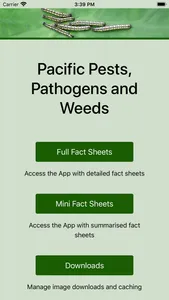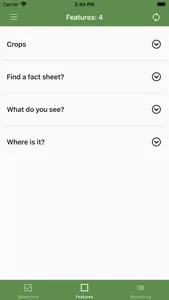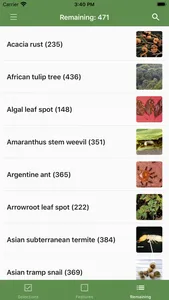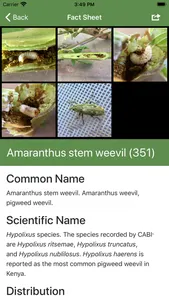PestNet and Pacific Pests, Pathogens & Weeds v12
When crop pests and diseases occur, farmers want help and advice immediately. They don't want to wait and in many cases they cannot wait. Unless they act quickly, the crop could be ruined.
This App gives extension staff and lead farmers all the information they need to treat the crop. If there is no way of saving a crop, the steps should help to prevent the problem occurring in the future.
What's new
In version 12, we again concentrate on common weeds. Eleven are weeds and seven of them are from Micronesia, although they also occur elsewhere in the Pacific islands and beyond. We thank Konrad Englberger, previously with the Pacific Community, for his help in this, especially for sharing images. Among the nine remaining new fact sheets, we have three on insects, two on fungi, two on viruses, one on a bacterium, and one on a nematode. All are in Oceania, except for the Tomato brown rugose fruit virus.
In version 11, we have added 10 common weeds suggested by Fiji. We have looked to the horizon again and added several pests, mostly diseases, that are not yet in the region but are nearby; these include some nasty bacterial diseases of bananas and a potentially devastating fruit fly. Pests of root crops have been a focus, irrespective whether they are already in the region, nearby or far. These include a ‘mixed-bag’ of diseases caused by fungi, nematodes, phytoplasmas and viruses, and complete our world survey of major pests of important root crops. Finally, we include a further six insect pests, all from within the region, and a fact sheet on developing an Insecticide Resistance Management strategy.
A new feature since v10 is access to the PestNet Community. This community network helps people anywhere in the world obtain advice and information on plant protection. PestNet users include crop growers, extension officers, researchers, and biosecurity personnel. PestNet was started in 1999 by the same people who developed PPP&W so putting the two together was thought to be a good idea! You can access PestNet from the main page of the App or from the bottom of every fact sheet. Once in Pestnet, you can filter for articles from the Internet, pest images sent for identification, or requests for advice. You can even filter for fact sheets!
You can view all the PestNet submissions without joining, but we ask you to join the PestNet Community if you want to post a submission or reply to one. This is to stop malicious automatic bots from interfering with our network. You can join by registering an active email address, or via social media. More information on the PestNet Community can be obtained from the website: https://www.pestnet.org
Acknowledgements
We would like to thank ACIAR, the Australian Centre for International Agricultural Research for providing support in the development of the App under a sub-regional (Fiji, Samoa, Solomon Islands and Tonga) IPM project (HORT/2010/090).
We thank Identic Pty Ltd., (https://www.lucidcentral.org) creators of Lucid and Fact Sheet Fusion for its development.
When crop pests and diseases occur, farmers want help and advice immediately. They don't want to wait and in many cases they cannot wait. Unless they act quickly, the crop could be ruined.
This App gives extension staff and lead farmers all the information they need to treat the crop. If there is no way of saving a crop, the steps should help to prevent the problem occurring in the future.
What's new
In version 12, we again concentrate on common weeds. Eleven are weeds and seven of them are from Micronesia, although they also occur elsewhere in the Pacific islands and beyond. We thank Konrad Englberger, previously with the Pacific Community, for his help in this, especially for sharing images. Among the nine remaining new fact sheets, we have three on insects, two on fungi, two on viruses, one on a bacterium, and one on a nematode. All are in Oceania, except for the Tomato brown rugose fruit virus.
In version 11, we have added 10 common weeds suggested by Fiji. We have looked to the horizon again and added several pests, mostly diseases, that are not yet in the region but are nearby; these include some nasty bacterial diseases of bananas and a potentially devastating fruit fly. Pests of root crops have been a focus, irrespective whether they are already in the region, nearby or far. These include a ‘mixed-bag’ of diseases caused by fungi, nematodes, phytoplasmas and viruses, and complete our world survey of major pests of important root crops. Finally, we include a further six insect pests, all from within the region, and a fact sheet on developing an Insecticide Resistance Management strategy.
A new feature since v10 is access to the PestNet Community. This community network helps people anywhere in the world obtain advice and information on plant protection. PestNet users include crop growers, extension officers, researchers, and biosecurity personnel. PestNet was started in 1999 by the same people who developed PPP&W so putting the two together was thought to be a good idea! You can access PestNet from the main page of the App or from the bottom of every fact sheet. Once in Pestnet, you can filter for articles from the Internet, pest images sent for identification, or requests for advice. You can even filter for fact sheets!
You can view all the PestNet submissions without joining, but we ask you to join the PestNet Community if you want to post a submission or reply to one. This is to stop malicious automatic bots from interfering with our network. You can join by registering an active email address, or via social media. More information on the PestNet Community can be obtained from the website: https://www.pestnet.org
Acknowledgements
We would like to thank ACIAR, the Australian Centre for International Agricultural Research for providing support in the development of the App under a sub-regional (Fiji, Samoa, Solomon Islands and Tonga) IPM project (HORT/2010/090).
We thank Identic Pty Ltd., (https://www.lucidcentral.org) creators of Lucid and Fact Sheet Fusion for its development.
Show More



